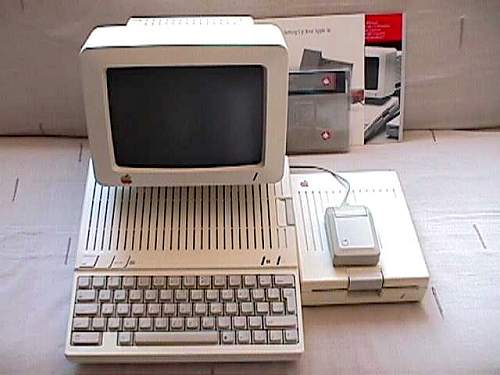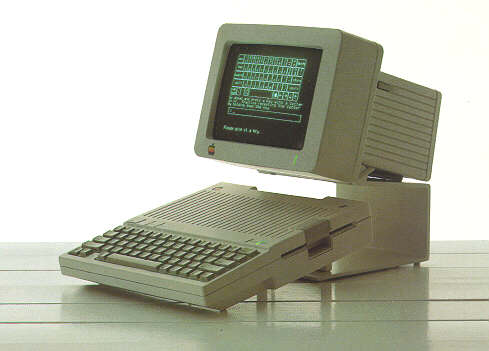Difference between revisions of "Apple IIc"
m |
m |
||
| Line 23: | Line 23: | ||
you really want to. Or less. | you really want to. Or less. | ||
-- Forbes | -- Forbes | ||
| + | |||
| + | [[Image:85apple.jpg]] | ||
== Apple II Forever == | == Apple II Forever == | ||
Revision as of 12:39, 6 July 2007
Apple ][c 2c IIc //c - Apple released the Apple IIc in April 1984, billing it as a portable Apple II, because it could be easily carried; however, it lacked battery power and a built-in display. The IIc even sported a carrying handle that folded down to prop the machine up into a typing position.
The Apple IIc was the first Apple II to use the updated 65C02 processor, and featured a built-in 5.25" floppy drive and 128 KB RAM, with a built-in disk controller that could control external drives, composite video (NTSC or PAL), serial interfaces for modem and printer, and a joystick/mouse port. Unlike previous Apple II models, the IIc had no internal expansion slots at all, this being the means by which its compact size was attained.
The final Apple II model was the Apple IIc Plus introduced in 1988. It was the same size and shape as the IIc that came before it, but the 5¼" floppy drive had been replaced with a 3½" drive, the power supply was moved inside (gone was the IIc's "brick on a leash" power supply), and the processor was a fast 4 MHz 65C02 processor that actually ran 8-bit Apple II software faster than the IIGS.
When the Apple IIc was introduced, the informative copy led off with a couple of asterisked sentences:
It weighs less than 8 pounds.*
And costs less than $1,300.**
In tiny type were these "fuller explanations":
* Don't asterisks make you suspicious as all get out? Well, all
this means is that the IIc alone weights 7.5 pounds. The power
pack, monitor, an extra disk drive, a printer and several bricks
will make the IIc weigh more. Our lawyers were concerned that you
might not be able to figure this out for yourself.
** The FTC is concerned about price fixing. You can pay more if
you really want to. Or less.
-- Forbes
Apple II Forever
The 1984 introduction of the compact Apple IIc, at a boisterous celebration in San Francisco's Moscone Center, is interrupted by a magnitude 6.2 earthquake. The party, called "Apple II Forever," doesn't miss a beat because loyal Apple II users are already shaken up by their belief the company is focusing too much on the Macintosh, even though the Apple II is generating the bulk of sales and profit.
Unfortunately, nothing is forever, not even the Apple II -- although it comes close. On Nov. 15, 1993, more than 16 years after it was introduced, and with over 5 million units shipped, Apple quietly drops the last of the line, the Apple IIe. As a gesture to the faithful, Apple continues offering Apple II technology through an expansion card for some early Mac LC and Performa models.
ADTPro for the IIc
This is a way to transfer data from that old Apple 2c to a modern PC. ADTPro is a SourceForge project.
Note that the original IIc motherboard is not able to operate the serial port at speeds higher than 300 baud, making serial transfers with that version unsupported. You can check the revision of your IIc by checking memory location 64447:
- if PRINT PEEK(64427) returns 255, you have an original IIc (ROM revision '255').
- if PRINT PEEK(64427) returns 0, you have an IIc with UniDisk 3.5 inch drive support (ROM revision '0').
- if PRINT PEEK(64427) returns 3, you have an IIc with memory expansion support (ROM revision '3').
- if PRINT PEEK(64427) returns 4, you have an IIc with a modified/fixed version of memory expansion support (ROM revision '4').
- if PRINT PEEK(64427) returns 5, you have an Apple IIc Plus (ROM revision '5').
Contiki for the IIc
The Contiki operating system is an open source, Internet-enabled, operating system designed for tiny systems and runs on a variety systems ranging from the Commodore 64 and the Atari Jaguar to small embedded micro-controllers. Oliver Schmidt and Glenn Jones now bring the Internet and the web to the classic Apple ][ by their Contiki Apple ][ port and Glenn's self-built Apple ][ Ethernet card.

